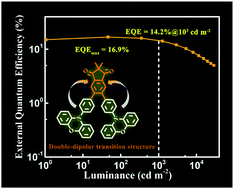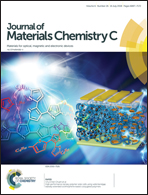Revealing the new potential of an indandione unit for constructing efficient yellow thermally activated delayed fluorescence emitters with short emissive lifetimes†
Abstract
Simultaneously accomplishing a high efficiency and a slow efficiency roll-off at practical luminance levels remains challenging for thermally activated delayed fluorescence (TADF) organic light-emitting diodes (OLEDs). In this study, for the first time, we reveal the new potential of an indandione unit featuring double carbonyl moieties, which is widely used in organic solar cells, as an electron-accepting core for constructing efficient TADF emitters. As a proof of concept, two TADF emitters, 5PXZ-PIDO and 5,6PXZ-PIDO, are developed by connecting an indandione (IDO) core with electron-donating phenoxazine (PXZ) units via phenylene π-bridges. Impressively, both emitters exhibit a distinct TADF nature with short DF lifetimes of ∼2 μs, and display relatively high photoluminescence quantum yields (ΦPLs) of over 70%. More importantly, a yellow OLED based on 5,6PXZ-PIDO achieves a high external quantum efficiency of 14.2% and an ultra-slow efficiency roll-off of 16.0% at a practical luminance of 1000 cd m−2, which is outstanding among previously reported carbonyl-based TADF emitters. This finding unlocks the huge potential of indandione-based molecules as TADF emitters for high-performance OLEDs.



 Please wait while we load your content...
Please wait while we load your content...